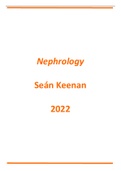Summary
Summary Nephrology / Renal Medicine Notes
- Course
- Institution
Nephrology notes detailing renal pathologies and conditions for medical school examinations. Notes made from multiple resources such as oxford handbook, question banks, university lectures and UK guidelines. Look at specialty section and content list for the summary contents of this file.
[Show more]



